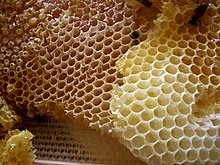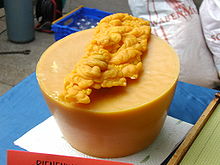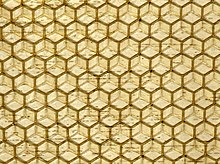
Back Byewas Afrikaans شمع العسل Arabic Arı mumu Azerbaijani Taro BCL Пчаліны воск Byelorussian Пчелен восък Bulgarian মৌমোম Bengali/Bangla Pčelinji vosak BS Cera d'abella Catalan Včelí vosk Czech



Beeswax (also known as cera alba) is a natural wax produced by honey bees of the genus Apis. The wax is formed into scales by eight wax-producing glands in the abdominal segments of worker bees, which discard it in or at the hive. The hive workers collect and use it to form cells for honey storage and larval and pupal protection within the beehive. Chemically, beeswax consists mainly of esters of fatty acids and various long-chain alcohols.
Beeswax has been used since prehistory as the first plastic, as a lubricant and waterproofing agent, in lost wax casting of metals and glass, as a polish for wood and leather, for making candles, as an ingredient in cosmetics and as an artistic medium in encaustic painting.
Beeswax is edible, having similarly negligible toxicity to plant waxes, and is approved for food use in most countries and in the European Union under the E number E901. However, due to its inability to be broken down by the human digestive system, it has insignificant nutritional value.[1]